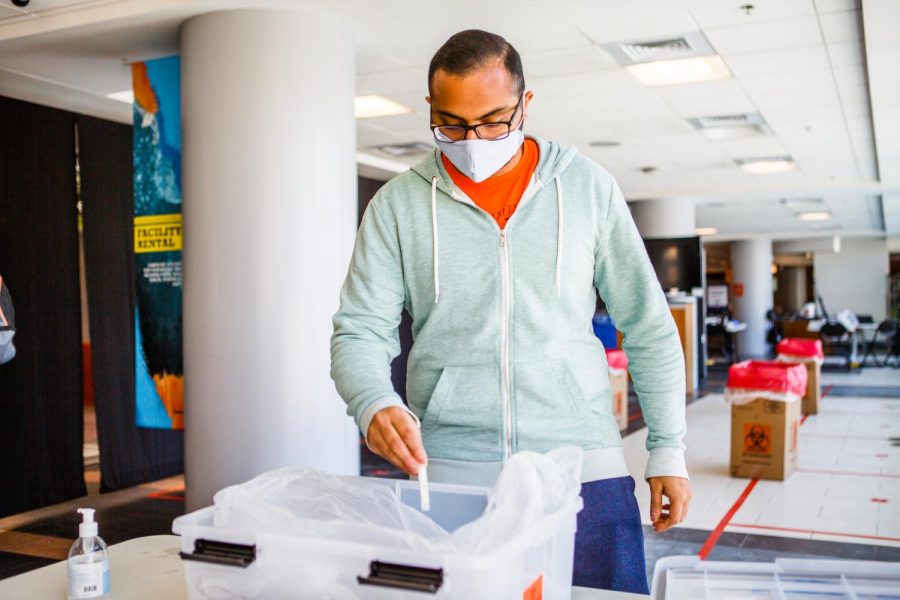UI’s COVID-19 testing program passes test of reopening campus
Student Anirudh Nandella deposits his completed University COVID-19 test into a receptacle at the ARC on Feb. 1. Testing at the University allowed for a safe return to campus by effectively identifying and quarantining infected individuals.
May 10, 2021
When the pandemic hit, the world all but stopped in its tracks. With no readily available way to screen for individuals infected with COVID-19, the University shuttered its classrooms and lecture halls, shifting instruction to the virtual world.
Over the summer, the University looked for a way to safely reopen the campus for the coming fall, albeit at a reduced capacity. And they found one.
In the intervening months, University researchers developed a simple and reliable COVID-19 test that only requires a saliva sample, rather than the more common and invasive nasal swab.
And so, during the summer, the University refitted a section of its Veterinary Diagnostic Lab into a COVID-19 testing lab.
There were some hiccups along the way, but the testing program did its job — the program made it possible for the University to reopen its campus despite the pandemic looming.
By continuously testing on-campus students, faculty and staff, the University was able to more effectively identify and quarantine infected individuals.
While the chaos of 2020 may seem like a distant memory today, the sheer scale of the University’s testing program at the start of last fall is nothing short of extraordinary.
The cavalcade of test results generated by the University caused state health officials to exclude the University’s tests from the state’s regional COVID-19 metrics for fear that it would distort the actual situation in Champaign.
In September, the University’s testing accounted for nearly 20% of all COVID-19 tests in the state and roughly 2% of all tests in the country
Of course, the University’s testing program was not without issues.
At the start of the fall semester, the surge of returning students and new freshmen put significant strain on the University’s COVID-19 testing lab in the VDL.
Despite being designed to conduct roughly 10,000 tests a day, for the first few weeks of the fall semester, the lab was receiving upwards of 18,000 tests per day.
This resulted in the tests arriving at the lab faster than it could process them and a backlog of saliva samples began to accumulate, with boxes of samples stacking from floor to ceiling at one point.
Additionally, the University ended up backtracking its claim that its saliva test was approved under an “umbrella” authorization by the Food and Drug Adminstration, after the agency notified the University that the test has not in fact been approved.
Despite these bumps in the road, most of the issues surrounding the University’s testing program have since been rectified.
When the spring semester began, the University spread the testing for returning students across several days by grade level, giving the VDL more time to process the tests.
To more effectively process tests, the University also began to automate some steps of the VDL’s testing process, such as purchasing four automated decapping robots to process saliva samples.
More importantly, the University’s saliva test finally received an Emergency Use Authorization from the FDA in late February, allowing the University to expand its testing program to the surrounding community.
With the rapid rate of vaccination against COVID-19, the University has announced that inoculated individuals who submit proof of vaccination will be able to opt out of the University’s testing program but are still required to social distance and use face masks.
While the path of recovery moves at a snail’s pace compared to last year’s rapid societal shutdown, at least this coming fall semester looks to be a welcome return to (relative) normalcy.







